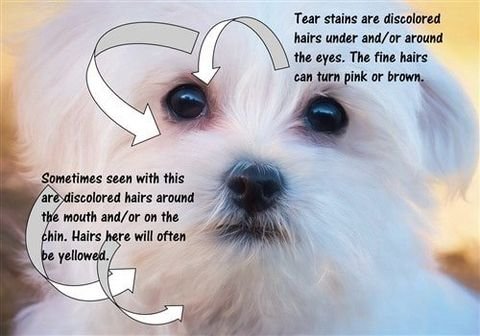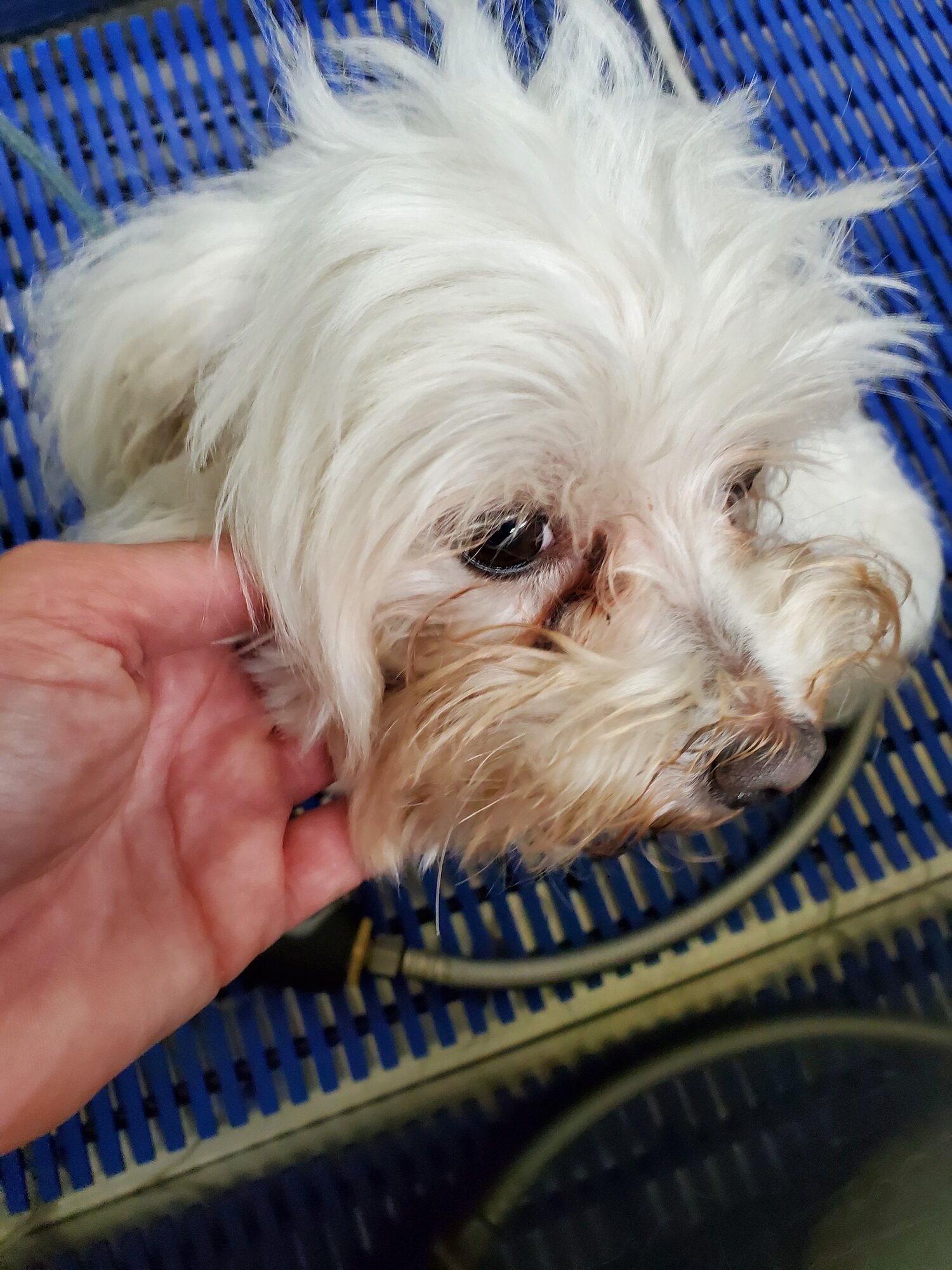Why do Maltese have red tear stains? It may surprise you to learn that these adorable dogs actually have a predisposition to tear stains. This is due to the shape and structure of their faces, which can cause tears to flow down their fur instead of being naturally cleared away.
The reason behind Maltese having red tear stains is multifaceted. Firstly, their facial structure with shallow eye sockets and prominent eyes can lead to excessive tearing. Additionally, tear stains are often caused by a combination of factors like diet, allergies, and eye infections. While keeping their faces clean and dry can help reduce the appearance of tear stains, it’s important to address the underlying causes to find a long-term solution for this issue.
-min-500x350-478w.jpg)
Why Do Maltese Have Red Tear Stains?
Maltese dogs are known for their beautiful, flowing white coats. However, many Maltese owners are confronted with a common issue: red tear stains. These reddish-brown streaks under the eyes can be unsightly and difficult to remove. In this article, we will delve into the reasons behind why Maltese dogs have red tear stains and explore potential solutions to this problem.
1. Genetics and Tear Duct Structure
One of the main reasons why Maltese dogs have red tear stains is their genetics. The coloring in their tears comes from a pigment called porphyrin, which is present in their tears, saliva, and urine. Maltese dogs, along with some other breeds, have a genetic predisposition to produce more porphyrin, leading to the formation of red tear stains.
Additionally, the structure of a Maltese’s tear ducts can contribute to tear staining. Some Maltese dogs have shallow eye sockets, which can cause the tears to overflow onto their fur instead of being properly channeled through the tear ducts. This overflow of tears, combined with the porphyrin pigment, creates the characteristic red tear stains.
To address this issue, breeders are working to selectively breed Maltese dogs with deeper and more efficient tear ducts, which can help minimize tear staining.
2. Allergies and Irritants
Allergies and irritants can also play a role in the development of red tear stains in Maltese dogs. Just like humans, dogs can be allergic to certain foods, environmental allergens, or substances they come into contact with. Allergic reactions can cause excessive tearing and eye irritation, leading to the formation of tear stains.
Common allergens for dogs include pollen, dust mites, certain ingredients in their food (such as beef or chicken), and even grooming products. If your Maltese has red tear stains and you suspect they may have allergies, it is important to consult with a veterinarian to determine the cause and develop an appropriate treatment plan.
Avoiding potential irritants, providing a hypoallergenic diet, and using gentle, tear-free grooming products can help reduce tear stains caused by allergies and irritants.
3. Epiphora and Eye Infections
Epiphora is a condition where tears overflow from the eyes and stain the fur. This can be caused by various factors, including abnormalities in the tear drainage system, eyelid conformation, or the presence of foreign objects in the eye. Epiphora can lead to the development of red tear stains in Maltese dogs.
In addition, eye infections such as conjunctivitis can contribute to tear staining. Bacterial or viral infections can cause inflammation of the eyes, leading to excessive tearing and the appearance of tear stains.
If you suspect that your Maltese has epiphora or an eye infection, it is crucial to seek veterinary care. Treatment may involve medications, tear duct flushing, surgical intervention, or addressing any underlying conditions contributing to the problem.
4. Diet and Water Quality
The diet and water quality of your Maltese can also impact the severity of tear staining. Some dog foods contain ingredients that may trigger allergies or contribute to tear production. Additionally, the mineral content of the water your dog drinks can affect tear staining.
Providing a high-quality, balanced diet that meets your Maltese’s nutritional needs can help improve their overall health and reduce tear staining. Opting for filtered or bottled water can also help minimize staining, as certain minerals in tap water may exacerbate tear staining.
Consulting with a veterinarian or canine nutritionist can provide valuable insights into choosing the right diet and water for your Maltese to prevent or reduce tear staining.
Caring for Your Maltese: Preventing and Managing Red Tear Stains
While it may be challenging to completely eliminate red tear stains in Maltese dogs, there are several strategies you can employ to prevent and manage the issue.
1. Regular Eye Cleaning
Regularly cleaning your Maltese’s eyes can help remove excess tears and prevent the buildup of tear stains. Use a gentle, tear-free eye cleanser recommended by your veterinarian or groomer. Moisten a clean cotton ball or soft cloth with the cleanser and gently wipe around the eyes, being careful not to irritate the delicate eye area.
It is essential to be consistent with eye cleaning to reduce the appearance of tear stains and maintain your Maltese’s eye health. Be cautious not to use harsh substances, such as hydrogen peroxide, as these can be harmful to your dog’s eyes.
2. Tear Duct Flushing
If your Maltese has epiphora or a tear duct blockage, your veterinarian may recommend tear duct flushing. This procedure involves using a saline solution to gently flush the tear ducts, removing any debris or blockages that may be contributing to the tear staining. Tear duct flushing should only be performed by a qualified veterinary professional.
3. Grooming and Trimming
Regular grooming and trimming around the eyes can help minimize tear staining. Keeping the hair around the eyes short and well-maintained can prevent tears from accumulating in the fur and reduce the visibility of tear stains. Be cautious when trimming around the eyes to avoid any accidents or injuries.
Conclusion
Red tear stains are a common issue for Maltese dogs, but understanding the reasons behind their occurrence can help you effectively manage and reduce them. Genetics, allergies, eye infections, and diet can all contribute to tear staining in Maltese dogs. Regular eye cleaning, tear duct flushing when necessary, and proper grooming techniques can help prevent and manage tear staining. Remember to consult with a veterinarian to determine the underlying cause of the tear stains and develop a tailored approach for your Maltese. With proper care and attention, you can help your Maltese maintain a healthy and tear stain-free appearance.
Key Takeaways: Why do Maltese have red tear stains?
- Maltese dogs have red tear stains due to excessive tear production caused by genetics or eye-related issues.
- Red tear stains are more visible on white fur, which is common in Maltese dogs.
- Poor diet and food allergies can contribute to the development of red tear stains in Maltese dogs.
- Eye infections or irritations can also lead to red tear stains.
- Regular grooming, cleaning the face, and using tear stain removers can help minimize red tear stains in Maltese dogs.
“Frequently Asked Questions”
Are you wondering why your beloved Maltese has red tear stains? Don’t worry, you’re not alone! Many Maltese dog owners encounter this issue with their furry companions. We’ve compiled a list of frequently asked questions to help you understand why Maltese dogs develop red tear stains and how to address this concern.
Q1: What causes red tear stains in Maltese dogs?
A1: Red tear stains in Maltese dogs are primarily caused by the dog’s tears containing excessive amounts of porphyrin, a pigment found in tears, saliva, and urine. When the tears come into contact with the hair around the eyes, it can lead to discoloration, resulting in those red or brown stains.
Some common causes for increased tear production in Maltese dogs include genetics, eye irritation, allergies, blocked tear ducts, or even certain diets. If the tear stains appear suddenly, it is recommended to consult with a veterinarian to rule out any underlying health issues.
Q2: Can grooming practices help prevent or minimize red tear stains in Maltese dogs?
A2: Proper grooming practices can indeed help prevent or minimize red tear stains in Maltese dogs. Keeping the area around the eyes clean and the hair trimmed can reduce the likelihood of tear stains. Regularly wiping the area with a gentle tear stain remover recommended by your veterinarian can also help in keeping the fur and skin clean.
Additionally, ensuring your Maltese has a healthy diet and providing them with fresh, clean drinking water can contribute to reducing tear stains. It’s important to note that while grooming practices can help minimize the appearance of tear stains, they may not completely eliminate them in some cases.
Q3: Are there any home remedies I can try to remove red tear stains from my Maltese?
A3: There are several home remedies that you can try to remove red tear stains from your Maltese. One common method is to use a mixture of equal parts hydrogen peroxide and water applied with a cotton ball to gently wipe away the stains. However, it is crucial to exercise caution and avoid contact with the eyes to prevent irritation.
Another popular home remedy involves using a tear stain removal product specifically formulated for pets. These products often contain ingredients like aloe vera and chamomile, which can help soothe the area and reduce the appearance of tear stains. It’s important to consult with your veterinarian before attempting any home remedies and to ensure that the products you use are safe for your dog.
Q4: Can tear stains in Maltese dogs be a sign of an underlying health issue?
A4: While tear stains in Maltese dogs are typically harmless and more of an aesthetic concern, they can sometimes be a sign of an underlying health issue. Excessive tear production can be caused by factors such as eye infections, allergies, or structural abnormalities in the tear ducts.
Therefore, it’s essential to monitor your Maltese’s overall health and consult with a veterinarian if you notice any other symptoms accompanying the tear stains, such as excessive tearing, redness, swelling, or discomfort in the eye area. Your veterinarian will be able to determine if there is an underlying health issue that needs to be addressed.
Q5: Can tear stain supplements or specialized diets help reduce red tear stains in Maltese dogs?
A5: Tear stain supplements or specialized diets can potentially help reduce red tear stains in Maltese dogs. These products often contain ingredients such as probiotics, antioxidants, and natural enzymes that can promote eye health and reduce tear staining.
It’s important to consult with your veterinarian before introducing any supplements or making any significant changes to your Maltese’s diet. Your veterinarian will be able to evaluate your dog’s specific needs and recommend the most appropriate supplements or dietary adjustments to minimize tear staining.
To achieve this, the writing should consist of concise sentences, with no more than 15 words each, to ensure that each idea is presented clearly. Finally, the objective is to provide the reader with a comprehensive understanding of the article’s main points within just two paragraphs.

